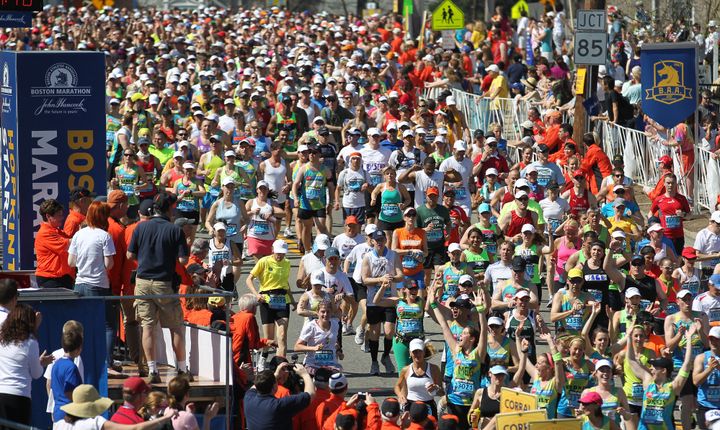
Boston Marathon runners faced unseasonably high and wildly inhumane temperatures in today's race. Possibly even hotter than the infamous "Run for the Hoses" race of 1976, this could prove to be the slowest and most dangerous Boston Marathon on record.
For those who have never understood marathon running or know little about the Boston Marathon in particular, it may seem insane that people would run at all, let alone in temperatures reaching the high 80s and possibly 90s. As a 2-time qualifier and participant in the hardest race I've ever run, allow me to explain.
Boston is the holy grail of marathon running in the U.S. and the world over. Before a little over a decade ago, the only way to officially enter the Boston Marathon was through running a qualifying time in another marathon. When I entered my first Boston in 2000, there were only two marathons in the U.S. that required qualifying times -- Boston and the Olympic trials. For marathon athletes, qualifying for and running Boston is the highest honor we can receive.
Boston is one of the toughest courses on the planet. It is extremely hilly, and it's not unusual to have the weather (usually cold and windy) play an integral role in the race. Chicago, on the other hand, is a very flat course making it an easier endeavor for the beginner or those who aren't built for speed or aren't completely devoted to putting in the miles. Training is critical to running any marathon, and certainly no assurance that tragedy won't strike. However, those who don't train well and/or don't have a strong level of fitness are in much more danger of injury or death in the 26.2 mile race.
Over the past forty years, the marathon has grown from an event executed by handfuls of hard core athletes to one for the masses. Unfortunately, this means that more than a few weekend warriors think running 26.2 miles in a row isn't as difficult as it truly is. And unfortunately, some lack the respect for the race necessary to successfully complete it or even live through it. Regardless of how hard you train and your level of fitness, you risk your life running the marathon. You can, however, greatly improve your odds (especially on difficult courses such as Boston) if you have put in the miles and have the body to run it.
Like many runners who qualified to run Boston (and as someone who ran her first race in New York City for the Leukemia Society), I wish non-qualified runners (those who can't run a qualifying time but are sponsors, vendors, foreign visitors, celebrities or are running for a charity) hadn't been allowed into the race. There are hundreds of marathons across the country. It was heartbreaking to see Boston begin to include runners who couldn't run qualifying times, many of whom use Boston as their first-ever marathon. The onslaught of unqualified participants not only detracts from the exclusivity of the race, but it keeps qualified runners out and makes Boston much more dangerous in the process.
Because of the physical demands of the course, Boston should not be a race for the novice. Those who run their first marathon in Boston are arguably more of a danger to themselves and others on the course because of their inexperience. Having run over a dozen marathons, I have a pretty good understanding of when to go on and when to quit a race. The countless hours I've spent in training and on courses here and abroad have given me great personal insight into what I can handle physically, and a healthy respect for the challenge of 26.2 continuous miles. This is simply knowledge and experience the novice cannot have.
Much like the ratings system at snow ski areas, marathon races should label courses for the runner's safety. Boston is no bunny hill. It is a double black diamond, complete with VW sized moguls, that deserves caution and warrants humility. Chicago, on the other hand, is a great beginner (or green course) marathon. Its flat terrain and the slower pace of its run makes it a great place to start one's distance career or put the one notch on the belt before going back to shorter races. And, although no marathon is 100 percent safe, Chicago (and others like it) is a healthier place for the novice to begin.
Allowing those who don't qualify into Boston is like letting a stable horse into the Kentucky Derby. Sure, the old gray mare can still run, but how well and at what level of safety? By putting rating systems into place and requiring qualifying times (or at least past marathon experience), the marathon community will be a much safer place for all of its warriors.
Sarah O'Leary is an author, marketing expert, licensed minister, and 15-time marathoner. She can be reached via email: sarahathuffpo@gmail.com.